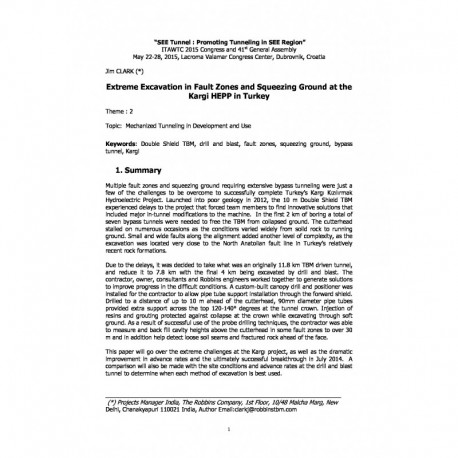Cart
0
0
No document
0,00 €
Total
Document successfully added to your shopping cart
Quantity
Total
There are 0 items in your cart.
There is 1 item in your cart.
Total documents
Total shipping
To be determined
Total
Search & filter
Search for a publication
Search & filter
Extreme Excavation in Fault Zones and Squeezing Ground at the Kargi HEPP in Turkey
clark_wtc_kargi_fullpaper_final
Multiple fault zones and squeezing ground requiring extensive bypass tunneling were just a few of the challenges to be overcome to successfully complete Turkey’s Kargı Kızılırmak Hydroelectric Project. Launched into poor geology in 2012, the 10 m Double Shield TBM experienced delays to the project that forced team members to find innovative solutions that included major in-tunnel modifications to the machine. In the first 2 km of boring a total of seven bypass tunnels were needed to free the TBM from collapsed ground. The cutterhead stalled on numerous occasions as the conditions varied widely from solid rock to running ground. Small and wide faults along the alignment added another level of complexity, as the excavation was located very close to the North Anatolian fault line in Turkey’s relatively recent rock formations. Due to the delays, it was decided to take what was an originally 11.8 km TBM driven tunnel, and reduce it to 7.8 km with the final 4 km being excavated by drill and blast. The contractor, owner, consultants and Robbins engineers worked together to generate solutions to improve progress in the difficult conditions. A custom-built canopy drill and positioner was installed for the contractor to allow pipe tube support installation through the forward shield. Drilled to a distance of up to 10 m ahead of the cutterhead, 90mm diameter pipe tubes provided extra support across the top 120-140° degrees at the tunnel crown. Injection of resins and grouting protected against collapse at the crown while excavating through soft ground. As a result of successful use of the probe drilling techniques, the contractor was able to measure and back fill cavity heights above the cutterhead in some fault zones to over 30 m and in addition help detect loose soil seams and fractured rock ahead of the face. This paper will go over the extreme challenges at the Kargı project, as well as the dramatic improvement in advance rates and the ultimately successful breakthrough in July 2014. A comparison will also be made with the site conditions and advance rates at the drill and blast tunnel to determine when each method of excavation is best used.




